The differential equation of all parabolas whose axis are parallel to the y-axis is (a) (b)(c)(d)(e)(f)d(g)3(h)(i)yj((k)d(l)x(m)3(n)(o))(p)(q)=0(r) (s) (b) (t)(u)(v)(w)(x)d(y)2(z)(aa)xbb((cc)d(dd)y(ee)2(ff)(gg))(hh)(ii)=C(jj) (kk) (c) ( d ) (e) (f)(( g ) (h) d^(( i )3( j ))( k ) y)/( l )(( m ) d (n) x^(( o )3( p ))( q ))( r ) (s)+( t )(( u ) (v) d^(( w )2( x ))( y ) x)/( z )(( a a ) d (bb) y^(( c c )2( d d ))( e e ))( f f ) (gg)=0( h h ) (ii) (d) ( j j ) (kk) (ll)(( m m ) (nn) d^(( o o )2( p p ))( q q ) y)/( r r )(( s s ) d (tt) x^(( u u )2( v v ))( w w ))( x x ) (yy)+2( z z )(( a a a ) dy)/( b b b )(( c c c ) dx)( d d d ) (eee)=C (fff) (ggg)
Parabola having axis parallel to y-axis, represent the quadratic function,
y=ax2+bx+c …………….(1)
Here, we have three effective constants: a,b and c.
y′=2ax+b
y''=2a
and y''=0, which is required differential equation.
Order of differential equation is three.
Related Playlists
- BOOK - CENGAGECHAPTER - DIFFERENTIAL EQUATIONSEXERCISE - Exercise 10.16videos
DIFFERENTIAL EQUATIONS
- BOOK - CENGAGECHAPTER - DIFFERENTIAL EQUATIONSEXERCISE - Exercise 10.26videos
DIFFERENTIAL EQUATIONS
- BOOK - CENGAGECHAPTER - DIFFERENT PRODUCTS OF VECTORS AND THEIR GEOMETRICAL APPLICATIONS EXERCISE - Exercise337videos
DIFFERENT PRODUCTS OF VECTORS AND THEIR GEOMETRICAL APPLICATIONS
- BOOK - CENGAGECHAPTER - DIFFERENTIATIONEXERCISE - Numerical Value Type3videos
DIFFERENTIATION
Similar Questions
An angle is double of its supplement. The measure of the angle is (a) (b)(c)(d)(e)60(f)0(g)(h) (i) (j) (b) (k)(l)(m)(n)120(o)0(p)(q)(r) (s) (t) ( u ) (v) (w) (x) 40^(( y )0( z ))( a a ) (bb) (cc) (d) (dd)(ee)(ff)(gg)80(hh)0(ii)(jj)(kk) (ll)
View SolutionIn Fig.97, If AB is parallel to CD, then the value of ∠BPE is (a) (b)(c)(d)(e)106(f)0(g)(h)(i) (j) (b) (k)(l)(m)(n)76(o)0(p)(q)(r) (s) (c) (d)(e)(f)(g)74(h)0(i)(j)(k) (l) (d) (m)(n)(o)(p)84(q)0(r)(s)(t) (u)
View SolutionIn Fig.93, if AOC is a straight line, then x= (a) (b)(c)(d)(e)42(f)0(g)(h)(i) (j) (b) (k)(l)(m)(n)52(o)0(p)(q)(r) (s) (c) (d)(e)(f)(g)142(h)0(i)(j)(k) (l) (d) (m)(n)(o)(p)38(q)0(r)(s)(t) (u)
View SolutionAn angle is thrice its supplement. The measure of the angle is (a) (b)(c)(d)(e)120(f)0(g)(h)(i) (j) (b) (k)(l)(m)(n)105(o)0(p)(q)(r) (s) (c) (d)(e)(f)(g)135(h)0(i)(j)(k) (l) (d) (m)(n)(o)(p)150(q)0(r)(s)(t) (u)
View SolutionIf angles of a linear pair are equal, then the measure of each angle is (a) (b)(c)(d)(e)30(f)0(g)(h)(i) (j) (b) (k)(l)(m)(n)45(o)0(p)(q)(r) (s) (c) (d)(e)(f)(g)60(h)0(i)(j)(k) (l) (d) (m)(n)(o)(p)90(q)0(r)(s)(t) (u)
View SolutionThe measure of an angle which is its own complement is (a) (b)(c)(d)(e)30(f)0(g)(h)(i) (j) (b) (k)(l)(m)(n)60(o)0(p)(q)(r) (s) (c) (d)(e)(f)(g)90(h)0(i)(j)(k) (l) (d) (m)(n)(o)(p)45(q)0(r)(s)(t) (u)
View SolutionTwo complementary angles are in the ratio 2:3. The measure of the larger angle is (a) (b)(c)(d)(e)60(f)0(g)(h)(i) (j) (b) (k)(l)(m)(n)54(o)0(p)(q)(r) (s) (c) (d)(e)(f)(g)66(h)0(i)(j)(k) (l) (d) (m)(n)(o)(p)48(q)0(r)(s)(t) (u)
View SolutionThe sum of an angle and half of its complementary angle is 750. The measure of the angle is (a) (b)(c)(d)(e)40(f)0(g)(h)(i) (j) (b) (k)(l)(m)(n)50(o)0(p)(q)(r) (s) (c) (d)(e)(f)(g)60(h)0(i)(j)(k) (l) (d) (m)(n)(o)(p)80(q)0(r)(s)(t) (u)
View SolutionTwo supplementary angles are in the ratio 3:2. The smaller angle measures (a) (b)(c)(d)(e)108(f)0(g)(h)(i) (j) (b) (k)(l)(m)(n)81(o)0(p)(q)(r) (s) (c) (d)(e)(f)(g)72(h)0(i)(j)(k) (l) (d) (m)(n)(o)(p)68(q)0(r)(s)(t) (u)
View SolutionThe sum of an angle and one third of its supplementary angle is 900. The measure of the angle is (a) (b)(c)(d)(e)135(f)0(g)(h)(i) (j) (b) (k)(l)(m)(n)120(o)0(p)(q)(r) (s) (c) (d)(e)(f)(g)60(h)0(i)(j)(k) (l) (d) (m)(n)(o)(p)45(q)0(r)(s)(t) (u)
View Solution


